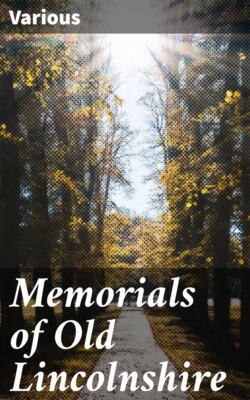Читать книгу Memorials of Old Lincolnshire - Various - Страница 12
Neolithic Burial Places
ОглавлениеThe burial places of early man in Lincolnshire must have been very numerous, judging from the remains we still have surviving to this day. These people were buried in barrows or large mounds of earth, which are called “Tumuli.”
In Lincolnshire the barrows are of two classes, called Long Barrows and Round Barrows.
The Long Barrow is the oldest form of interment, and belonged to the race of people called Dolicho-cephalic, or long-headed people. Sir John Lubbock says: “The Long Barrows are like the Gang-graben of Scandinavia, in which the dead are buried and not burnt.”
It is in the Long Barrows that we find this Neolithic race of people buried their dead in Lincolnshire.
One of the Long Barrows still exists at Swinhope, near Grimsby, and there are others in different parts of the county.
In a map of Lincolnshire, published about 1570, by Saxton, the position of some of the barrows was indicated. From that map we have compiled the following list, but the list includes both kinds of barrow, long and round—there being no indication on the map to distinguish the one form of barrow from the other:—
Aukborough, 2.
Ashby.
Barkstone.
Barnetby.
Barrow, 2.
Barton.
Belton.
Binbrook.
Bonby.
Boothby Graffoe.
Bottesford, 2.
Blyborough.
Branston, 3.
Braceby.
Burton-upon-Stather, 2.
Caburn.
Carlton, North.
Caythorpe.
Clixby.
Coleby.
Coleby, near West Halton, 4.
Cranwell.
Croxby.
Croxton.
Cuxwold, 2.
Dunston, 2.
Ferriby, 2.
Fillingham.
Frodingham, 2.
Fulbeck.
Glentworth.
Grange de Lings, 2.
Grantham, 2.
Harmston.
Hatcliffe, 2.
Haydour.
Hemswell, 2.
Horkstow, 2.
Howsham.
Hybaldstow, 2.
Ingham.
Kirmond le Mire.
Limber, 2.
Londonthorpe, 2.
Manby.
Manton, 2.
Mere Hospital, 2.
Messingham.
Metheringham.
Navenby, 2.
Nettleham.
Normanby.
Normanton.
Rauceby, 2.
Redbourne.
Riby.
Riseholme.
Rothwell.
Ropsley.
Rowston.
Saxby.
Scampton.
Scawby.
Scopwick.
Scotter, 2.
Scotton, 2.
Searby.
Southorp.
Spridlington.
Stainton le Vale.
Thoresway, 2.
Thornton, 3.
Ulceby.
Waddington, 2.
Walesby.
Walcot.
Welby.
Welton.
Welton le Wold, 2.
Willoughton.
Wootton.
Worlaby, 3.
Wrawby.
Wyham.
The custom of raising a mound over the place where the dead are buried is very ancient, widespread, and continuous to the present day: examples are to be seen in Egypt, India, America, and Britain. In its simple form it is seen in the village churchyard, in its greatest development it is seen in the magnificent pyramids of Egypt.
In the Long Barrows no metal implements are found unless they have been used for what are called “secondary interments.”
The date of these Long Barrows is variously stated; Canon Greenwell says, “probably 1000 B.C., but may be much earlier”; others say they were probably made 3000 B.C. or 5000 years ago. The definite date cannot be given, but only probabilities stated.
It is in this Neolithic Age that the bodies of the dead were placed in a cist or stone box; that is, large stones were placed round the body, and on these upright stones was fixed a covering stone.
One such system of burial was found at Rothwell, near Caistor, and another at Dunholme.
In nearly every case of burial of this kind, which is called Inhumation, the body has been placed facing the sun in a contracted position; that is, with the knees drawn up to the chin and lying on its side. Some specialists think this position indicates the sleeping attitude, others think it points to the fact that as the child entered into life in a contracted position, so the dead body was similarly placed for departure from life, with the possibility of entering into a new life after death.
Frequently by the side of the dead body were placed the weapons that he used when living—axe-heads, arrow-heads, knives, and spear-heads.
